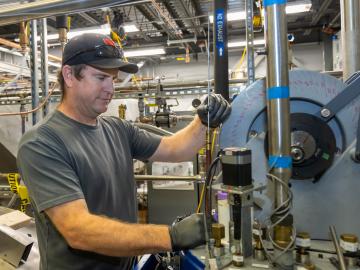Filter News
Area of Research
News Type
News Topics
- (-) 3-D Printing/Advanced Manufacturing (10)
- (-) Biomedical (1)
- (-) Clean Water (6)
- (-) Cybersecurity (1)
- (-) Energy Storage (8)
- (-) Nanotechnology (3)
- (-) Nuclear Energy (13)
- (-) Physics (4)
- Advanced Reactors (7)
- Artificial Intelligence (7)
- Big Data (7)
- Bioenergy (2)
- Biology (1)
- Biotechnology (1)
- Buildings (4)
- Chemical Sciences (1)
- Climate Change (7)
- Composites (2)
- Computer Science (17)
- Critical Materials (1)
- Decarbonization (4)
- Environment (14)
- Fusion (4)
- Grid (4)
- High-Performance Computing (2)
- ITER (1)
- Machine Learning (5)
- Materials (2)
- Materials Science (14)
- Mercury (1)
- Microscopy (3)
- Molten Salt (1)
- National Security (2)
- Neutron Science (9)
- Polymers (3)
- Quantum Science (3)
- Security (1)
- Simulation (2)
- Space Exploration (3)
- Summit (2)
- Sustainable Energy (5)
- Transportation (11)
Media Contacts

Associate Technician Sean Hollander is the keeper of the Fundamental Neutron Physics Beamline, which is operated by the Physics Division at the Spallation Neutron Source at ORNL, where scientists use neutrons to study all manner of matter.

ORNL scientists develop a sample holder that tumbles powdered photochemical materials within a neutron beamline — exposing more of the material to light for increased photo-activation and better photochemistry data capture.

Mohamad Zineddin hopes to establish an interdisciplinary center of excellence for nuclear security at ORNL, combining critical infrastructure assessment and protection, risk mitigation, leadership in nuclear security, education and training, nuclear security culture and resilience strategies and techniques.

Groundwater withdrawals are expected to peak in about one-third of the world’s basins by 2050, potentially triggering significant trade and agriculture shifts, a new analysis finds.

An international team using neutrons set the first benchmark (one nanosecond) for a polymer-electrolyte and lithium-salt mixture. Findings could produce safer, more powerful lithium batteries.

Canan Karakaya, a R&D Staff member in the Chemical Process Scale-Up group at ORNL, was inspired to become a chemical engineer after she experienced a magical transformation that turned ammonia gas into ammonium nitrate, turning a liquid into white flakes gently floating through the air.

Chelsea Chen, a polymer physicist at ORNL, is studying ion transport in solid electrolytes that could help electric vehicle battery charges last longer.

ORNL climate modeling expertise contributed to a project that assessed global emissions of ammonia from croplands now and in a warmer future, while also identifying solutions tuned to local growing conditions.

Louise Stevenson uses her expertise as an environmental toxicologist to evaluate the effects of stressors such as chemicals and other contaminants on aquatic systems.

Electric vehicles can drive longer distances if their lithium-ion batteries deliver more energy in a lighter package. A prime weight-loss candidate is the current collector, a component that often adds 10% to the weight of a battery cell without contributing energy.




